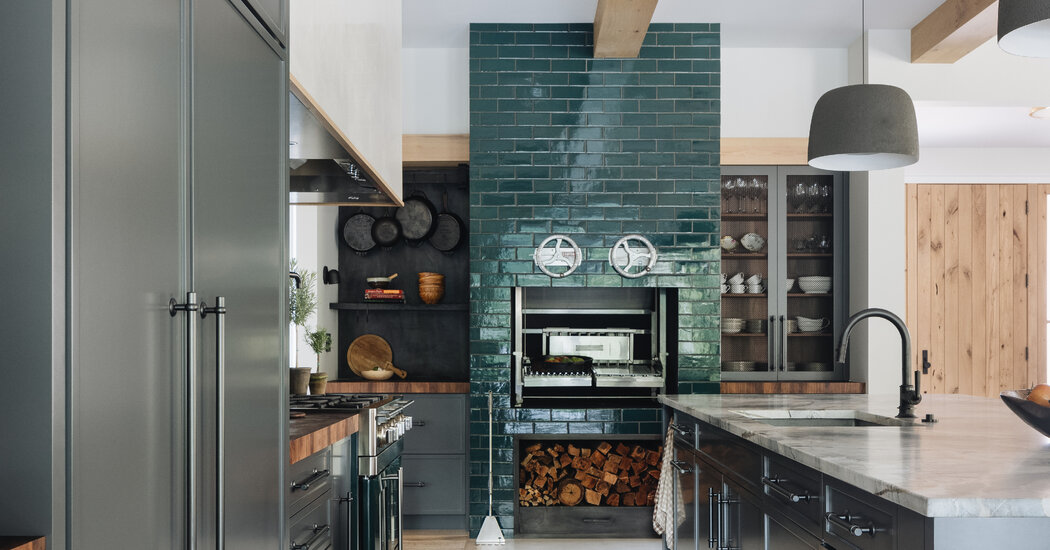This article is part of our Design special section about how food inspires designers to make and do surprising things.
The monster was dirty. Some would call it ugly. Almost everyone said, “Make it go away.” But for Julie Buckner, it was love.
Smack in the center of her kitchen was a built-in brick grill and rotisserie, original to the 1953 midcentury-modern ranch house in the hills of Oakland, Calif. Naysayers — builders, real estate agents, family — warned her that it was a fire hazard and could crumble in an earthquake, that the outdated behemoth would do no favors to the property’s value. Ms. Buckner, a designer whose office is in Sonoma County, Calif., ended up demolishing the kitchen in a renovation she completed in 2020, but was adamant about keeping the built-in oven.
When she decided to sell the house in 2021, she received 18 offers over the list price of $1.5 million. The oven was “well received,” noted her real estate agent, Hope Broderick, who estimated that it elevated the home’s value by $300,000 because it was quaint and operational (more or less) — a point of interest for the cooking-oriented clientele of the area.
“The people who wanted to purchase the home put a lot of value on the rotisserie,” Ms. Broderick said, adding that a property’s similar “desirable” features usually increase offers by $50,000 to $100,000. (This house ended up selling for $2.45 million, in large part because of the frenzied pandemic market.)
Wood-burning ovens are regular denizens of outdoor kitchens and backyard patios — hail the pizza king or queen! But building a hearth-like ensemble in the heart of a home is a different story. It takes moxie and ingenuity and sometimes a crane.
For Chuck Bevilacqua in San Diego, a health care executive who is of Italian descent (his grandparents owned an Italian restaurant on the North End of Boston), the kitchen of his dreams wouldn’t be complete without a place to bake Neapolitan pizza. His interior designer, Kristin Kostamo-McNeil, of Anne Rae Design, was worried about smoke billowing inside the kitchen once the pie crisped up inside an 800-degree-Fahrenheit cove.
A lucky happenstance — a shared wall with an outdoor patio fireplace — solved the problem. A 42-inch-diameter wood-burning dome was installed in a cavity and enclosed with concrete blocks. The ventilation pipe came out of the top of the dome so that the oven had its own flue.
Still there were hiccups: “Due to the unit’s size and the surrounding block, we couldn’t get the structure flush into the wall, resulting in a slight ‘bump out,’” said Robert Dodds, the general contractor on the project. But this was of little concern once Ms. Kostamo-McNeil wrapped the dome in natural split-face stacked limestone veneer evoking European farmhouse style.
Others who covet wood-fired ovens in their kitchens have to build them from scratch. “The construction is as complicated, or as simple, as building a fireplace — you need a foundation and proper ventilation and an exhaust to draw the smoke up,” said Eric J. Smith, a New York City architect.
For the kitchen of an original Spanish Colonial ranch house in western Texas, he added both a pizza oven and a South American grill known as an asado. The asado came with modern amenities, including a stainless steel carriage that could be raised and lowered as the stacks of burning logs turned to coal. (Fireproof lightbulbs put a spotlight on the action.) The pizza oven sat in a traditional arched opening of reclaimed firebrick surrounded by white hand-textured plaster. Mesquite, cherry and hickory logs were stacked below. “From a planning standpoint, you don’t want to run outside to get your wood,” Mr. Smith said.
Signing on to such culinary throwbacks means giving up the convenience of a quick meal. At Churchtown Dairy, a working farm in Hudson, N.Y., a rotisserie chicken dinner can take up to seven hours to prepare — four hours for the 40-inch-diameter wood-fired oven to warm up, and three more to roast the bird.
For Marina Case of the Red Shutters, an interior designer involved with the project, the wait time is not a big deal. “Slow cooking brings people together and reminds us to put away devices and return to primitive and simple living,” she said. Should you want to join in the delayed rewards, the farm, which was founded by Abby Rockefeller, the ecologist granddaughter of John D. Rockefeller, is scheduled to open its doors to overnight guests on Thursday; rates start at $1,600 per night.
Rick Anderson, a designer and builder, took charge of the farm oven’s white glazed brick rotisserie. It was his idea to engineer the spit so that it rotated in hypnotic circles. The surrounding masonry was inspired by Scottish Highland kitchens. “It almost looks like subway tile,” he said, “but the bricks are four inches thick, rather than being a veneer, and have more depth and sheen.”
In Chicago’s western suburbs, a couple of professional chefs asked Amy Storm, an interior designer, to go modern with their private kitchen inferno. She installed a wood-fired Grillworks grill in a column of glossy green tile. The grill allows for different cooking temperatures, regulated by an adjustable platform operated by a crank wheel just above the firebox.
“We wanted it to feel almost like the oven had been there forever and the house was built around it,” Ms. Storm said.
Authenticity comes at a price, however. It takes 20 to 30 kiln-dried logs to get the proper coal base, so the process is “expensive and impractical, unless you know what you’re doing,” she said. If her clients were to do it over, she added, they would put in a gas line.
The exertion of installing these behemoths also can be expensive and impractical. Cathy Purple Cherry, the founder of an architecture company with headquarters in Annapolis, Md., needed a crane to lower a pizza oven into a basement wine cellar that was used for entertaining. “It is like this big masonry animal,” she said. “You can’t dolly a 900-pound item down the steps.”
Venting is another challenge. Ms. Buckner, in California, found out the hard way that the original ventilation system of her midcentury treasure was not up to par. Rather, it was irreversibly capped below the roof.
“My ventilation plan was to turn the range’s vent hood on high and open all the windows and doors in advance of firing up the grill to get air circulating,” she recalled. “All was well until I threw the steaks on, but once they began cooking, the dripping fat caused fire to flare.” She finished off the steaks in the broiler.
The oven, which she discovered lacked a temperature gauge, became filthy after each use, she said, and cleanup was “not a breeze.” The appliance that drove up the value of her home turned out to be “less about cooking, and more of a design detail, a showpiece paying homage to the home’s original architectural features.”
How much will charm set you back? Expect to pay $3,700 for Mr. Bevilacqua’s indoor pizza oven and more than $8,000 for the one Ms. Purple Cherry lowered into the basement. Then, there is the cost of surrounding materials and additional labor, which can tack on $10,000 to $30,000 more, experts say.
Consumers are not fazed. Benjamin Eisendrath, the owner of Grillworks, said orders for built-in wood-fired kitchen grills rose 70 percent during the pandemic. And interest remains strong.
“We’re seeing a natural progression from renovation to new home builders asking for our grills,” he said. “And rather than simply dropping a grill onto a patio, they want it aesthetically integrated into their space.”
As Mr. Smith pointed out: “People intrinsically, and maybe subconsciously, like to stand and sit around the fire. But it’s one thing to toast marshmallows and another thing to cook dinner.”




